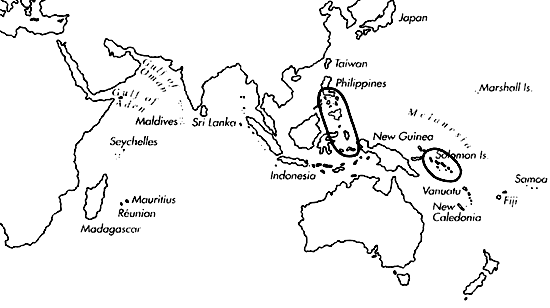
Skip Navigation Links
View access keys for this site.

Description: Moderately small, moderately light. Last whorl ventricosely conical to sometimes conoid-cylindrical; outline convex adapically, less so to straight below. Aperture wider at base than near shoulder. Shoulder angulate to sometimes subangulate. Spire low, outline concave. Teleoconch sutural ramps flat, with 1 increasing to 2-3 major spiral grooves; on last ramp, spiral sculpture may be weak or include 2 additional minor spiral grooves. Last whorl with broad spiral ribbons below centre, narrow or replaced by ribs within basal third. Specimens from Solomon Is. (Pl. 39, Fig. 29) matching typical C. broderipii in shell morphology except for larger size and higher weight. Specimens from Philippines (Pl. 39, Figs. 30-32) and E. New Britain moderately small to medium-sized, moderately solid; relative weight of similarly-sized specimens may vary by 50%. Last whorl sometimes narrower than in typical C. broderipii, occasionally ovate; left side may be sigmoid. Aperture almost uniformly wide in small adults, becoming wider at base during growth. Shoulder angulate to rounded. Spire of low to moderate height, outline concave to slightly sigmoid. Larval shell of 2-2.25 whorls, maximum diameter 0.8-1 mm. Teleoconch sutural ramps that to slightly convex, with 0- 1 increasing to 2-6 spiral grooves (sometimes 3 major and 3 minor grooves); spiral sculpture may be variably weak in latest whorls. Last whorl with spiral ribbons on basal half or third, split into narrow ribbons or ribs toward base; ribs may be few ( 1-2) to numerous (20), restricted to anterior end or extending across basal third.
| Shell Morphometry | ||
|---|---|---|
| L | - | |
| RW | - | |
| RD | - | |
| PMD | - | |
| RSH | - | |
Ground colour white. Last whorl with spirally aligned light to reddish brown dots, spots and bars concentrated or fused into 3 spiral bands, below shoulder, above centre and within basal third. Pattern elements may also fuse into axial streaks or occasionally form a loose meshwork. Basal part of columella and siphonal fasciole generally immaculate. Larval whorls white to pale grey. Teleoconch spire with radial streaks and blotches matching last whorl pattern in colour. Aperture violet to light purple, with or without a darker collabral band. In specimens from Solomon Is., last whorl with 3 brownish beige spiral bands, below shoulder, above centre and within basal third; dotted to solid brown spiral lines extending from base to shoulder. Brown spots and flecks concentrated above, between and below the both adapical beige bands. Late sutural ramps with beige to brown radial markings; middle ramps with brown dots at outer margins. In specimens from Philippines and E. New Britain, last whorl with spirally aligned light to dark brown tlecks, axial streaks and tlames below shoulder and on each side of centre; markings tend to fuse axially as well as spirally; spiral arrangement may be emphasized by interrupted to continuous brownish beige underlying bands. Dotted or dashed darker brown spiral lines may occur from base to shoulder, usually restricted to spiral colour bands. Shells with a mainly axial arrangement of last whorl pattern intergrade with shells with solid spiral bands and dotted spiral lines. Larval whorls white. Early postnuclear sutural ramps white or beige, immaculate. Following sutural ramps with radial markings matching last whorl pattern in colour and intensity. Aperture rose to orange or violet, usually demarcated from white marginal zone by an orange-brown collabra1 band.
Periostracum olive-grey, thin, translucent, smooth.
Habitat and Habits: No information on typical C. broderipii and specimens from Solomon Is.; specimens from Philippines and E. New Britain in shallow-subtidal zone to about 20 m.
Discussion: C. broderipii is similar to C. collisus, C. andamanensis, C. sertacinctus and C. spectrum. C. collisus has a more conical last whorl (PMD 0.80-0.90) with a generally more angulate shoulder; the typical form of C. collisus is distinguished from C. broderipii also by its larger size (L to 60 mm). C. andamanensis differs mainly in the weaker spiral sculpture on its late sutural ramps, the uniform spiral sculpture of its last whorl consisting of rather equally broad ribbons basally, and in the less convex outline of its ast whorl. For comparison with C. sertacinctus and C. spectrum, see the Discussions of the latter species. The description of typical C. broderipii is based on the holotype (Pl. 39, Fig. 26) and closely corresponding shells preserved in BMNH, ZMA, and MNHN (Pl. 39, Figs. 27, 28). All these shells are reported from Moluccas (except for the specimen in MNHN, whose locality "Andaman" may be erroneous). The specimens from Solomon Is. (Pl. 39, Fig. 29) are very close to typical C. broderipii in shell shape and sculpture, while its colour pattern is closer to the dark form of C. sertacinctus. The populations from Philippines (Sulu Sea to Manila Bay) were considered conspecific with typical C. broderipii (Pl. 39, Figs. 30-32) by Coomans et al. ( 1982), although the differences in shell morphology and colour pattern do not support this suggestion. We only provisionally retain the taxonomic placement suggested by Coomans et al. Morphologically identical shells are known from E. New Britain (Rabaul area).

C. broderipii range map
This section contains verbatim reproductions of the accounts of 316 species of Conus from the Indo-Pacific region, from Manual of the Living Conidae, by Röckel, Korn and Kohn (1995). They are reproduced with the kind permission of the present publisher, Conchbooks.
All plates and figures referred to in the text are also in Röckel, Korn & Kohn, 1995. Manual of the Living Conidae Vol. 1: Indo-Pacific Region.
The range maps have been modified so that each species account has it own map, rather than one map that showed the ranges of several species in the original work. This was necessary because each species account is on a separate page on the website and not confined to the order of accounts in the book.
Return to framed version (returns to search page)